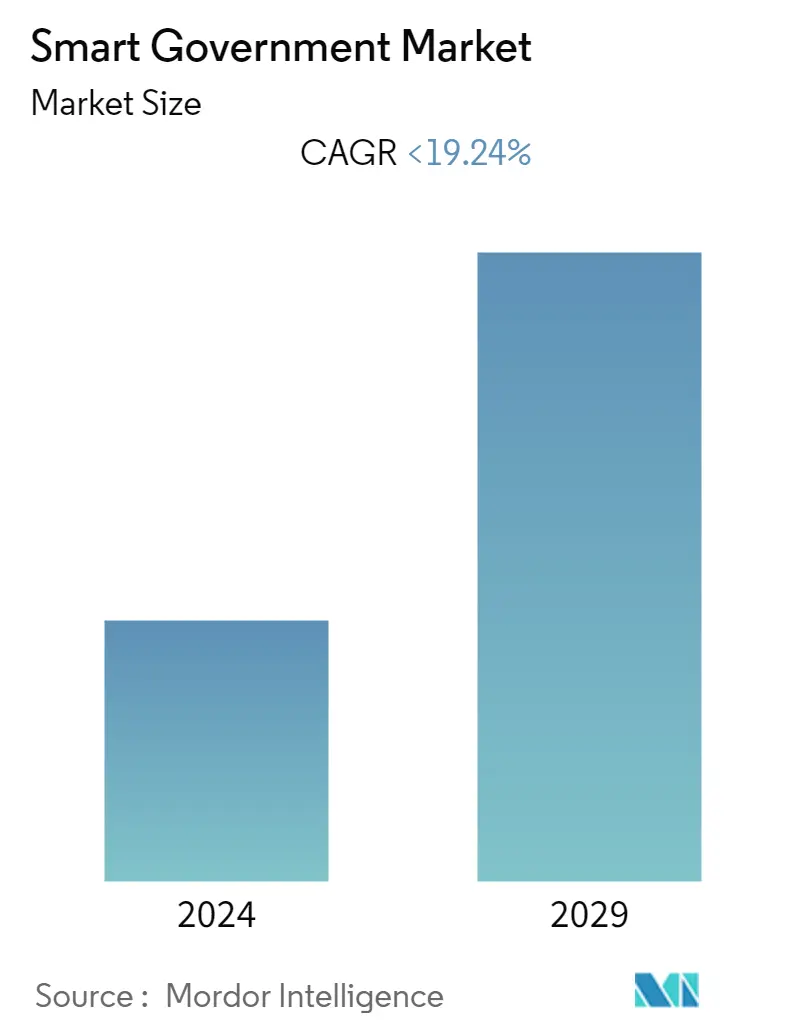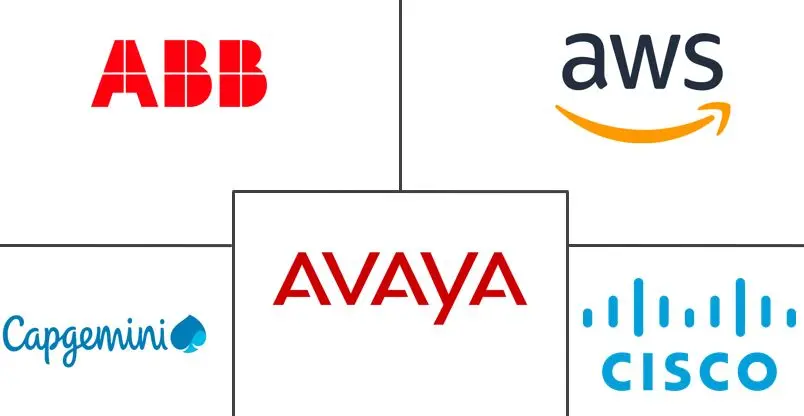Market Size of Smart Government Industry

| Study Period | 2019 - 2029 |
| Base Year For Estimation | 2023 |
| CAGR | < 19.24 % |
| Fastest Growing Market | Asia Pacific |
| Largest Market | North America |
| Market Concentration | Low |
Major Players
*Disclaimer: Major Players sorted in no particular order |
Smart Government Market Analysis
The smart government market is expected to register a CAGR of 19.24% during the forecast period. The main factor driving the market is the ability of the citizen to interact with the government service in a new way due to the rising smart technologies by governments across various countries.
- The generation of government data is expanding due to several factors, including the growing census data (ever-increasing population), new policies and initiatives, partnerships with other regions, and an increase in GDP due to the mushrooming of new businesses. Physical hardware-based legacy systems may be more efficient but also run out of space. As a result, there is an increasing demand for smart governance.
- For instance, the city of Louisville in the United States offers junk pickup reminders to residents via GovDelivery, segmented by location, to better coordinate sanitation services. More than 12,000 households signed up to receive text message alerts one week and one day before garbage collection.
- Vendors are offering public, private, or hybrid cloud solutions for government data related to its administration, security, backup, or compliance, making the cloud for the government the newest big thing.
- On a global scale, the systematic openness of government data has increased rapidly. The cloud facilitates government data transparency, which promotes government accountability and reduces corruption. Furthermore, it contributes to citizen empowerment and resolving complex societal issues by utilizing a broader range of skills and information.
- However, smart governance has many advantages, the government faces numerous challenges. For example, the government requires significant resources and commitment to build digital infrastructure and connect everything online. Developing countries face financial difficulties due to various development initiatives, poor tax collection, significant foreign debt, trade deficits, and other social issues.
- In terms of supply, the COVID-19 pandemic has wreaked havoc on the economies of small, medium, and large-scale enterprises that manufacture the hardware tools required for global service deployment. Lockdowns imposed on individual nations by governments worldwide (to stop the virus from spreading) have made matters worse by damaging global supply chains and disrupting manufacturing activities.
Smart Government Industry Segmentation
Smart Government is an extension of e-government, which applies information, communication, and operational technologies to all operational areas across multiple domains, process areas, and jurisdictions to generate sustainable public value.
The scope of the study is currently focused on key regions such as North America, Europe, Asia-Pacific, Latin America, and Middle East & Africa. The study also tracks the key market parameters, underlying growth influencers, and major vendors operating in the industry, which supports the market estimations and growth rates over the forecast period.
The market sizes and forecasts are provided in terms of value (USD million) for all the above segments.
| By Type | ||||||||
| ||||||||
|
| By Deployment | |
| On Premise | |
| Cloud |
| By Geography | |
| North America | |
| Europe | |
| Asia Pacific | |
| Latin America | |
| Rest of World |
Smart Government Market Size Summary
The smart government market is experiencing significant growth, driven by the increasing integration of smart technologies into government services worldwide. This transformation is enabling citizens to interact with government services in innovative ways, enhancing transparency, accountability, and citizen empowerment. The expansion of government data, fueled by factors such as population growth, new policies, and economic development, is necessitating the shift from traditional hardware-based systems to smart governance solutions. The adoption of cloud computing is particularly noteworthy, as it supports data transparency and facilitates efficient communication between governments and citizens. Despite the advantages, challenges such as the need for substantial resources to build digital infrastructure and financial constraints in developing countries persist. The COVID-19 pandemic has further underscored the importance of digital transformation, disrupting supply chains and highlighting the necessity for quick access to information and efficient communication.
In North America, the smart government market is bolstered by the adoption of smart infrastructure and city initiatives, with the Internet of Things (IoT) and cloud computing playing pivotal roles. The region's market growth is supported by significant investments in smart government services and solutions, such as the microgrid movement and smart mobility deployments. The digital-government ecosystem is evolving, with strong policies in place to digitize government operations in the United States and Canada. The market is characterized by fragmentation, with major players like ABB Ltd, Amazon Web Services Inc., and Cisco Systems Inc. engaging in strategic partnerships and product development to expand their market share. Recent developments include Google's establishment of Google Public Sector and Microsoft's launch of a new government cloud environment, both aimed at accelerating digital transformations in the public sector.
Smart Government Market Size - Table of Contents
-
1. MARKET INSIGHTS
-
1.1 Market Overview
-
1.2 Industry Value Chain Analysis
-
1.3 Industry Attractiveness - Porter's Five Forces Analysis
-
1.3.1 Bargaining Power of Suppliers
-
1.3.2 Bargaining Power of Consumers
-
1.3.3 Threat of New Entrants
-
1.3.4 Intensity of Competitive Rivalry
-
1.3.5 Threat of Substitute Products
-
-
1.4 Impact of COVID-19 on the Market
-
-
2. MARKET SEGMENTATION
-
2.1 By Type
-
2.1.1 Solution
-
2.1.1.1 Government Resource Planning System
-
2.1.1.2 Remote Monitoring
-
2.1.1.3 Security
-
2.1.1.4 Other Solutions (Open Data Platform and Network Management)
-
-
2.1.2 Service
-
2.1.2.1 Financial
-
2.1.2.2 Healthcare
-
2.1.2.3 Power and Utilities
-
2.1.2.4 Telecom
-
2.1.2.5 Oil and Gas
-
2.1.2.6 Other Services (Education and Transportation)
-
-
-
2.2 By Deployment
-
2.2.1 On Premise
-
2.2.2 Cloud
-
-
2.3 By Geography
-
2.3.1 North America
-
2.3.2 Europe
-
2.3.3 Asia Pacific
-
2.3.4 Latin America
-
2.3.5 Rest of World
-
-
Smart Government Market Size FAQs
What is the current Smart Government Market size?
The Smart Government Market is projected to register a CAGR of less than 19.24% during the forecast period (2024-2029)
Who are the key players in Smart Government Market?
Amazon Web Services, Inc., Avaya Inc., Cisco Systems, Inc., ABB and Capgemini are the major companies operating in the Smart Government Market.

